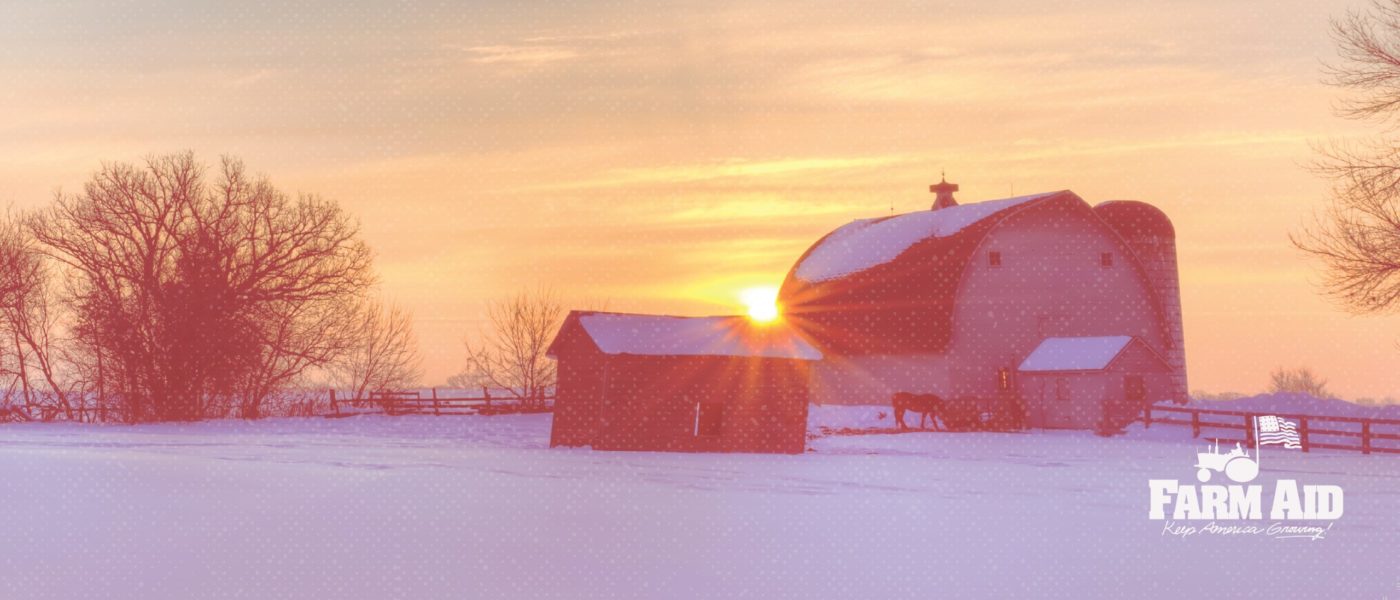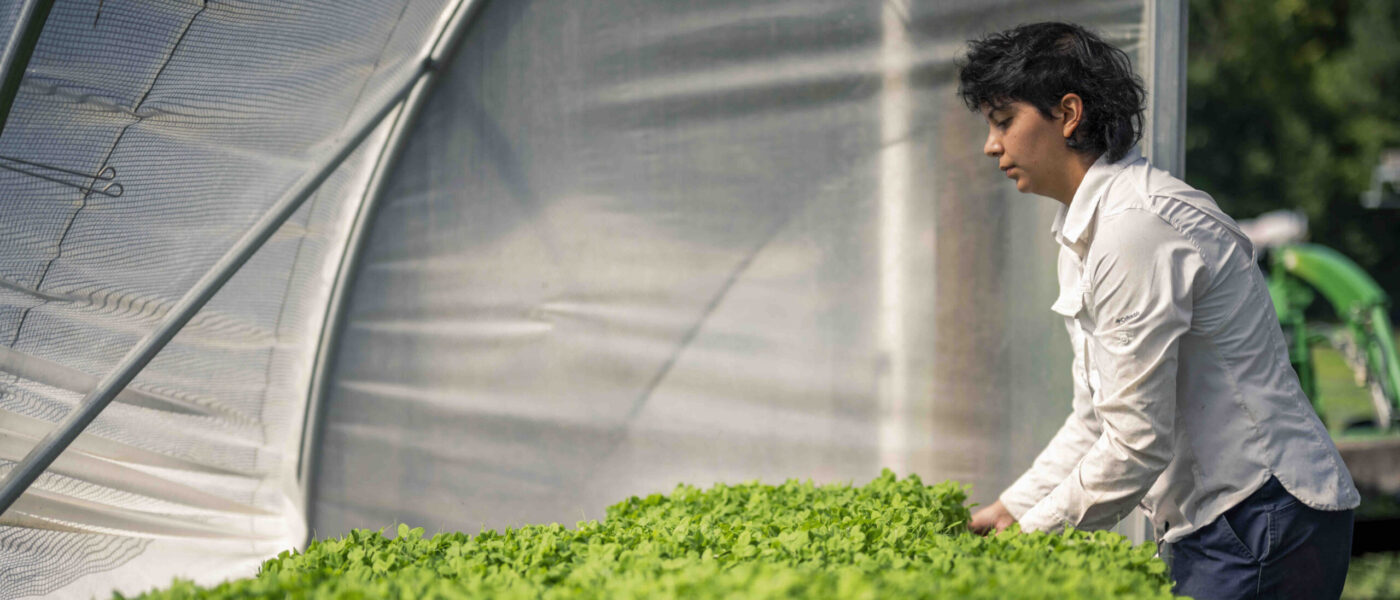September 2010
No offense, but what has Farm Aid really done all these years aside from put on a good concert?
Neil K.
Beaverton, OR
Well Neil, I can’t say we’ve never been asked that question before. Whether you’re a farmer, concertgoer, Farm Aid member, long-time donor to Farm Aid, or someone who’s just getting to know us as an organization, you may wonder just what we do and what we’re really all about. As we plan our 25th anniversary concert, Farm Aid 25: Growing Hope for America, it seems an appropriate time to reflect on what we’ve been up to the past 25 years, what we’ve accomplished, and how agriculture has changed since Farm Aid began.
A Concert and So Much More
To understand Farm Aid’s work today and why we do what we do, it’s helpful to take a peek in the rearview mirror.
In the 1980s, family farmers faced a crisis the likes of which hadn’t been seen since the Great Depression. Spurred in part by a set of misguided federal policies that served the interests of big agribusinesses, farmers were told to “get big or get out” and expand production to take advantage of export markets. American farmers acted accordingly, taking on huge amounts of debt and working to produce records yields, but the foreign markets they were promised dried up.
That spelled trouble with a capital ‘T’. At the peak of the farm crisis, plummeting farm product prices and land values, rising interest rates, troubled credit markets and unfair lending practices pushed tens of thousands of farms out of business, forcing nearly one million people off their land in a single 12-month period. This massive loss of family farms closed down the many small businesses—banks, feed and supply stores, farm equipment stores—that both supported farmers and relied on farmers for support. In turn, Main Streets were shuttered nationwide, creating persistent poverty throughout rural America.
It was in this context that Willie Nelson, John Mellencamp and Neil Young organized the first Farm Aid
concert on September 22, 1985, in Champaign, Illinois. Aiming to raise money for family farmers and awareness around the threats they faced, the concert featured 54 acts before an audience of 78,000 concertgoers. Farm Aid established its 1-800-FARM-AID hotline at that time to take donations. In total, the event raised $9 million while the Farm Aid hotline was flooded with calls from both donors with donations and farmers seeking help or offering solutions.
The concert clearly struck a chord. Willie, John and Neil figured federal policy makers would feel the pressure to craft a solution immediately. Farm Aid, you see, was intended to be a one-time event. But as farm problems persisted and more family farmers were forced into bankruptcy and foreclosure, it was clear the problem wasn’t going away anytime soon. With each passing year since the first Farm Aid concert in 1985, Farm Aid’s Board of Directors have felt the same urgent need to host another concert. Farm Aid’s mission remains as relevant as ever in our 25th year.
The Roots of a Movement
Immediately following the 1985 concert, Farm Aid distributed the money raised to organizations around the country that provided emergency grants to farm families, offered crisis prevention services and worked to address farm policy at state and federal levels. Those first grants helped plant the seeds of a robust family farm movement that continues to this day and is still the core of Farm Aid’s work and funding activities.
In addition to providing funds for the on-the-ground work of keeping family farmers on the land, Farm Aid created its own programs to effect change. For example, in 1986 Farm Aid organized the United Farmer and Rancher Congress, an unprecedented gathering of nearly 3,000 farmers from across the country. David Senter, then leader of the American Agriculture Movement (AAM), recalls the power of the event. “It created a platform where everybody could forget their differences and be unified to work on something collectively. The ‘changing of the caps’ stands out to me. All the farmer-delegates had caps on from their respective organizations—AAM, National Farmers Union, National Farmers Organization, Farm Bureau, etc. Everyone took them off, put them down, and put on a white United Farmer and Rancher Congress hat to show unity. It made the hair stand up on the back of my neck. That [show of unity] set Farm Aid apart from every other organization.”
The United Farmer and Rancher Congress strengthened the growing campaign for farm credit law reform led by Farm Aid-funded partners the National Family Farm Coalition (NFFC), the Western Organization of Resource Councils (WORC) and the Farmers Legal Action Group (FLAG). This campaign saw victory as Congress passed the Agricultural Credit Act of 1987, a law that saved tens of thousands of family farms from foreclosure. Willie himself followed up on this victory by sending a letter to 90,000 farmers around the country, informing them about their rights under the new law.
New Threats, New Efforts
Despite the progress made to address farm credit issues, family farmers still faced a number of threats and new ones were always on the horizon. While Farm Aid has stayed true to its mission of keeping family farmers on the land and thriving, manifesting that mission has asked us to tackle these new challenges.
For example, in the 1990s, Farm Aid was hearing from farmers about the rise of factory farms and growing corporate control over meat production. On April 1, 1995, Willie joined farmers and community activists to protest a huge factory hog farm in Lincoln Township, Missouri. The event was a rallying cry for farmers and consumers angered by the pollution associated with factory farms and the loss of family hog farms. From that rally was born the Campaign for Family Farms and the Environment, a multi-state campaign to halt factory farming.
Similarly, Farm Aid sprung into action when we heard about the introduction of genetically-engineered seeds and the pressures seed companies placed on family farmers. Farm Aid organized two informational meetings around genetically-engineered (GE) seeds for farmers at our concerts in 1999 and 2000. These summits eventually led to the crafting of the Farmers’ Declaration on Genetic Engineering in Agriculture, which called for a moratorium on GE seeds, and the Farmer to Farmer Campaign on Genetic Engineering in Agriculture.
Farm Aid has also worked to grow what we call the Good Food Movement, fostering consumer demand for good food grown by family farmers and working to create markets that allow farmers a different option than industrial, corporate-dominated commodity markets. We accomplish this not only through our grant program, but also on our website and newsletter, where we feature Farmer Heroes who represent the best of our food system, and the Ask Farm Aid column, where we answer our readers’ questions about farmers, their food, and the food system at large. In 2009, we also launched our Action Center so our readers can weigh in on pressing issues and push policymakers and corporations to make the food system more fair. We’ve worked hard to offer our concertgoers better options too, sourcing from family farms and ethical food companies at our HOMEGROWN concessions at Farm Aid concerts since 2007.
To this day, Farm Aid still operates the 1-800-FARM-AID hotline and is committed as ever to responding to the needs of farmers in times of disaster. This work ranges from organizing emergency farmer-to-farmer hay lifts to bring hay from one part of the country to livestock in drought-stricken areas, to launching the Family Farm Disaster Fund, which galvanizes fundraising activities for disaster regions. In 2005, when Hurricanes Katrina and Rita devastated the Gulf Coast, Farm Aid mobilized within days to respond to the needs of farm families. Farm Aid sent truckloads of donated food and distributed over $230,000 in emergency grants to farm families in Texas, Louisiana, Alabama, and Mississippi. We also sponsored five trainings for farmers and advocates to help farmers through the long and involved process of applying for federal disaster programs. Farm Aid’s Farmer Resource Network, the outgrowth of our hotline, links farmers not only with the resources they need in times of crisis, but also with new opportunities to diversify their farm business, transition to organic or sustainable practices, and participate in local and regional markets that foster economic development in their communities.
Still Growing Hope
As any farmer can tell you, change takes time. Some of the seeds you plant today won’t take root and blossom for many months, some for years, and some not at all. Systemic change comes with its clashes, its tensions, its breakthroughs and setbacks. Sticking with it takes a mixture of patience and tenacity.
It’s true that many family farmers still face the fight of their lives, just as they did in the 1980s. Today, a price crash in the dairy sector continues to threaten thousands of family farmers and corporate control increasingly dominates agriculture, fostering unfair and anticompetitive market conditions for farmers and eaters alike.
And yet, things aren’t the same as in 1985. More and more people want to learn about their food, where it comes from, how it was grown. They want to support a food system that cares about our planet, our health and our farmers. Farmers and eaters are committed to creating something better and are joining Farm Aid in the effort to keep family farmers on the land, growing good food for more and more Americans.
Over the past 25 years, we’ve worked for deep, systemic change in our food system: change that takes the corporate agriculture model out from its roots and instead fosters a food system that works for farmers and eaters alike. While this is a daunting task that no one group can accomplish on its own, we are more hopeful than ever that together with a growing movement for Good Food this vision can be our reality.



